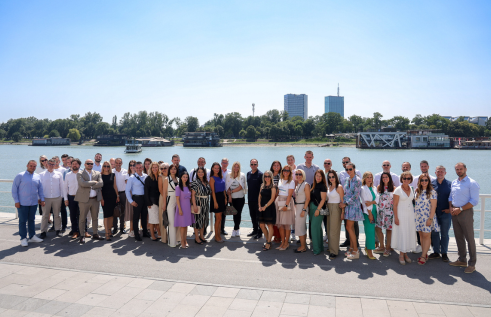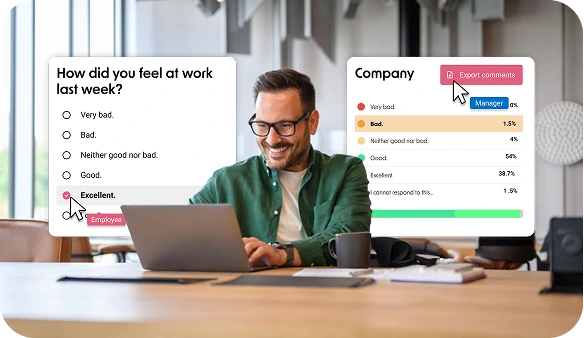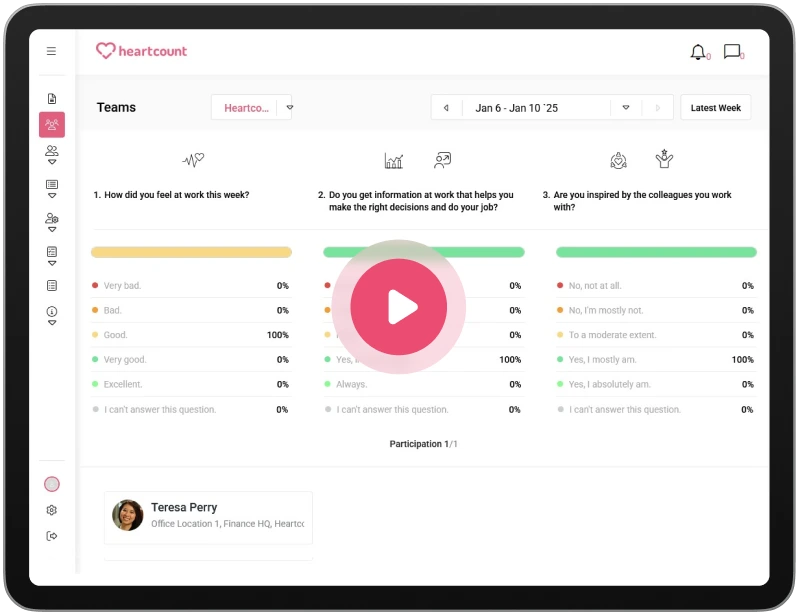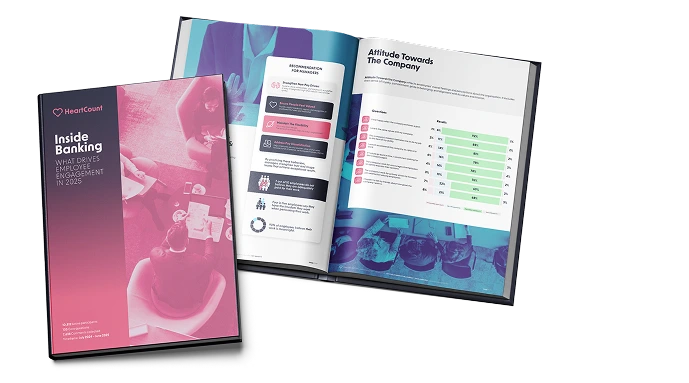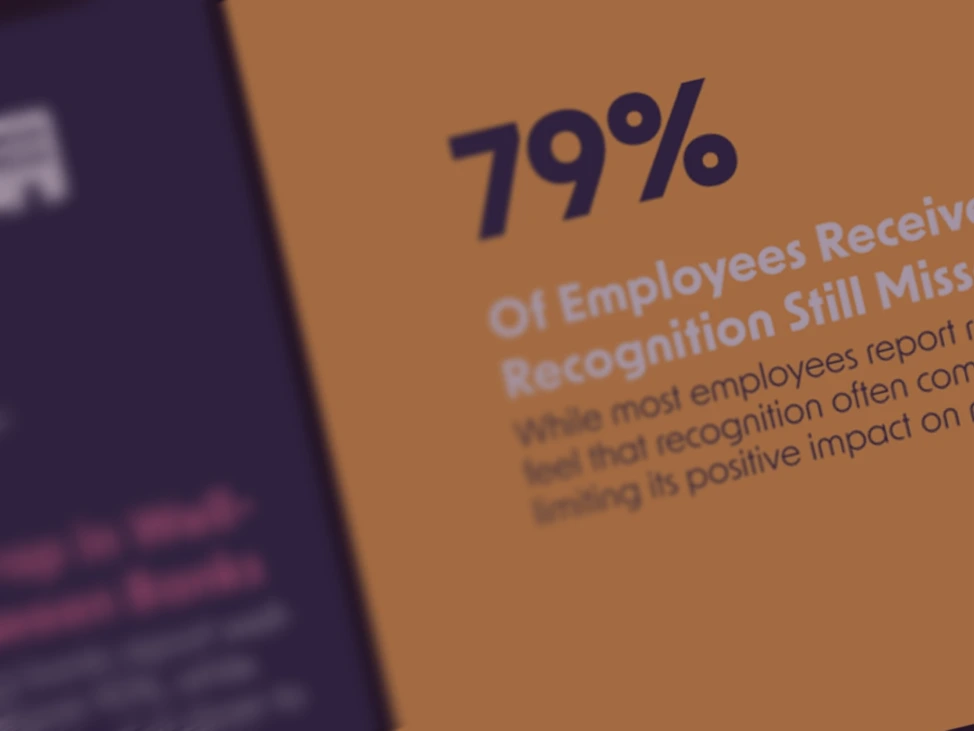21 Employee Retention Strategies That Work in 2025: Improve Loyalty & Reduce Turnover

Employee retention is emerging as a make-or-break issue for organisations in 2025. According to Gallup’s State of the Global Workplace report, global employee engagement dropped to just 21% in 2024, with disengagement costing the global economy a staggering $438 billion in lost productivity. This trend poses a real risk: when people aren’t invested in their work, turnover climbs, team effectiveness drops, and culture starts to fray.
If you’re feeling the pressure of rising attrition, struggling to keep key performers, or simply want to stay ahead of workforce shifts, this guide is for you. We’ve compiled 21 research-backed, practical strategies to help improve loyalty, engagement, and resilience in your organisation.
Plus, if you’re ready to move from theory to action, HeartCount offers real‑time pulse surveys, AI‑powered risk alerts, and recognition tools that help you measure and reinforce what matters.
Employee retention is emerging as a make-or-break issue for organisations in 2025. According to Gallup’s State of the Global Workplace report, global employee engagement dropped to just 21% in 2024, with disengagement costing the global economy a staggering $438 billion in lost productivity. This trend poses a real risk: when people aren’t invested in their work, turnover climbs, team effectiveness drops, and culture starts to fray.
If you’re feeling the pressure of rising attrition, struggling to keep key performers, or simply want to stay ahead of workforce shifts, this guide is for you. We’ve compiled 21 research-backed, practical strategies to help improve loyalty, engagement, and resilience in your organisation.
Plus, if you’re ready to move from theory to action, HeartCount offers real‑time pulse surveys, AI‑powered risk alerts, and recognition tools that help you measure and reinforce what matters.
What is Employee Retention and Why it Matters in 2025
In simple terms, employee retention is an organisation’s ability to keep its people engaged, committed, and working for the company over time. While some turnover is inevitable, a high retention rate means you’re succeeding in creating an environment where employees want to stay.
In 2025, retention is more than just an HR metric—it’s a strategic advantage. With talent shortages in key industries and rising employee expectations for flexibility, purpose, and growth, companies that invest in retaining their workforce will outperform competitors in resilience and profitability.
Retention vs. Attrition
It helps to understand the distinction:
- Retention measures how many employees choose to stay with you over a given period.
- Attrition measures the natural reduction in staff, whether through resignations, retirements, or other departures.
Put simply, retention is what you actively build; attrition is what you risk if you don’t.
The ROI of Keeping Your Top Talent
Retaining your best people isn’t just about avoiding the costs of hiring replacements (though that’s significant—estimates suggest replacing a single employee can cost 50–200% of their annual salary). It’s also about protecting the institutional knowledge, customer relationships, and cultural cohesion that drive performance.
According to Gallup, highly engaged teams—where employees feel valued and are more likely to stay—deliver:
- 23% higher profitability
- 18% higher productivity
- 43% lower turnover
When you invest in retention strategies, you’re also investing in growth, stability, and the ability to navigate change with confidence.
Why Employees Leave: 5 Root Causes
Even the most engaged teams aren’t immune to turnover. Understanding why employees leave is the first step toward designing retention strategies that actually work. While every organisation has its own dynamics, most voluntary departures boil down to a handful of predictable causes:
- Lack of growth opportunities – When employees don’t see a clear path to develop their skills or advance their careers, they’re more likely to look elsewhere.
- Inadequate recognition – People who feel undervalued or invisible are more prone to disengagement and exit.
- Poor management – As the saying goes, employees don’t leave companies, they leave managers.
- Compensation and benefits gaps – If pay and benefits lag behind market expectations, retention becomes an uphill battle.
- Burnout and work-life imbalance – Prolonged stress, unsustainable workloads, and lack of flexibility are among the top drivers of turnover.
COLLECT
21 Proven Employee Retention Strategies (Grouped by Pillar)
Below, you’ll find 21 evidence-based employee retention strategies, grouped into seven key pillars. Each tactic is designed to help you build a workplace where people want to stay—and grow.
Leadership & Communication
Strong leadership and open communication form the foundation of trust. These strategies help you create clarity, reduce uncertainty, and keep employees aligned with your mission.
1. Set a clear vision and priorities
Employees are more likely to stay when they understand the bigger picture. Regularly communicate your organisation’s vision, strategic goals, and how each role contributes to success.
Pro Tip: Clear priorities also help reduce confusion about expectations. When people know exactly what matters most, they can make decisions with confidence and stay focused on shared objectives.
2. Communicate transparently and frequently
Transparent communication helps reduce uncertainty and builds trust. This is especially vital during organisational change or periods of high growth. Proactive updates and open channels show employees they’re respected and informed. Clear communication also supports a culture of workplace transparency, which strengthens loyalty.
Pro Tip: Regular check-ins, all-hands meetings, and honest updates about challenges create a sense of stability even when the future feels unpredictable.
3. Use stay interviews to surface risks early
Stay interviews are one of the most effective ways to understand what keeps employees engaged—and what might drive them away. By asking thoughtful questions before issues escalate, you can address concerns in real time.
Pro Tip: Document insights from these conversations and look for patterns across teams. Even small adjustments based on employee feedback can have a big impact on retention.
Growth & Career Mobility
Employees are far more likely to stay when they see a future for themselves. The tactics below encourage development, learning, and clear career progression.
4. Create internal mobility programs
Give employees pathways to explore different roles and departments. Internal mobility not only boosts engagement but also reduces the costs and ramp-up time of external hires.
Pro Tip: When employees see examples of colleagues moving up or sideways in the company, they’re more likely to believe their own career can grow without leaving.
5. Offer mentorship and coaching
Pair employees with mentors or coaches to support their development. Structured mentoring builds connections and reinforces a sense of belonging.
Pro Tip: Mentorship also helps newer employees feel supported during transitions, reducing the likelihood of early attrition.
6. Invest in learning and development with clear pathways
Training budgets alone don’t guarantee growth. Outline clear progression maps and link learning opportunities to career milestones so employees can envision their future with you.
Pro Tip: Give employees input on their learning plans so they feel ownership over their growth.
Recognition & Engagement
Recognition isn’t just about rewards—it’s about helping people feel seen and valued. Here are practical ways to weave appreciation into your everyday culture.
7. Launch a real-time kudos system
Real-time recognition helps reinforce positive behaviours and keeps motivation high. Digital tools make it simple to celebrate contributions as they happen.
Pro Tip: Even a short public message of appreciation can strengthen trust and signal that great work is noticed.
8. Celebrate milestones big and small
Acknowledging work anniversaries, personal achievements, or project wins shows employees they matter. Small celebrations create lasting goodwill.
Pro Tip: Personalising these moments—like mentioning specific contributions—makes recognition more meaningful.
9. Empower peer-to-peer recognition
Encourage colleagues to recognise one another’s efforts. Peer-to-peer recognition can be even more meaningful than top-down praise and helps build community. For inspiration, explore how peer-to-peer recognition strengthens culture.
Pro Tip: Make recognition visible across the team so it reinforces positive behaviours and sets an example for others.
Well-being & Work-Life Balance
Supporting employees as whole people—not just workers—builds loyalty and reduces burnout. The following approaches can strengthen well-being and balance.
10. Monitor burnout through pulse surveys
Short, frequent check-ins can help you spot early signs of disengagement and overload. Automated tools such as employee pulse surveys make it easier to gather honest feedback without survey fatigue.
Pro Tip: Be sure to close the loop by sharing what you learn and how you plan to act on the results.
11. Promote flexible work options
Flexibility remains a top priority for employees in 2025. Where possible, offer hybrid arrangements, flextime, or compressed workweeks to help people balance work and life.
Pro Tip: Clear guidelines around flexibility help avoid misunderstandings and ensure consistency across teams.
12. Offer wellness stipends or resources
Support holistic well-being through stipends for fitness, mental health apps, or wellness programmes. Prioritising employee well-being sends a clear message that you care about your team beyond their output.
Pro Tip: Small gestures, like encouraging employees to take regular breaks, also contribute to a healthier work culture.
Manager Enablement
Managers are often the deciding factor in whether employees stay or leave. These strategies equip leaders with the tools and accountability to drive retention.
13. Train managers in retention tactics
Equip managers with the skills to lead effectively, provide feedback, and foster inclusion. A well-trained manager is often the difference between engagement and turnover. If managers lack support or guidance, even the best retention plans can falter.
Pro Tip: Reinforce training with ongoing coaching or peer learning sessions so managers can share what works.
14. Provide tools like nudges and alerts
Technology can help managers stay aware of engagement trends. Nudges and alerts ensure that no one slips through the cracks when workloads increase.
Pro Tip: Over time, these tools create habits of proactive check-ins and early intervention.
15. Set accountability through OKRs or goals
Make retention a shared responsibility. Incorporate retention and engagement metrics into managers’ objectives to reinforce their importance. You can also link objectives to initiatives like how to drive employee engagement for better alignment.
Pro Tip: When retention goals are visible and measured, they stay top of mind amid competing priorities.
Compensation & Benefits
Competitive pay and meaningful perks remain critical retention levers. These ideas will help you keep compensation fair and appealing.
16. Benchmark salaries regularly
Keep compensation competitive by reviewing benchmarks at least annually. Transparent pay practices help build trust and reduce the risk of attrition.
Pro Tip: Communicate how your compensation philosophy aligns with market trends and employee expectations.
17. Add high-impact, low-cost perks
Small perks—like home office stipends, birthday gifts, or learning allowances—can make a big impression without requiring a large budget.
Pro Tip: Consider surveying employees about which perks they value most to ensure relevance.
18. Build employee stock or ownership programmes
When employees share in the success they help create, they’re more motivated to stay long term.
Pro Tip: Equity programmes can also reinforce a sense of fairness and shared destiny across the organisation.
Strategic HR Tactics
Retention isn’t static—it requires ongoing measurement and iteration. The tactics below connect your retention efforts to broader business outcomes.
19. Track retention metrics with clarity
Use a mix of lagging and leading indicators—like exit data, engagement scores, and tenure trends—to understand where you stand.
Pro Tip: Visual dashboards make it easier for leaders to act on insights quickly.
20. Build exit data into continuous improvement
Don’t just file away exit interviews—use them to inform process improvements and leadership development. If you’re refining your approach, you may also find our guide on exit interviews helpful.
Pro Tip: Regularly reviewing exit data can reveal trends you might otherwise miss.
21. Align retention goals to business outcomes
Frame retention as a driver of strategic objectives, not just an HR metric. When leaders see its connection to growth and profitability, they’re more likely to invest in lasting solutions.
Pro Tip: Linking retention to customer satisfaction or project delivery timelines can further illustrate its impact.
Remote & Hybrid Retention Tips
Retaining employees in distributed environments requires extra care. Without a shared physical space, it’s easy for people to feel disconnected or overlooked. These strategies can help you build trust, visibility, and belonging—no matter where your teams work.
Recognition in async environments
Remote employees can’t rely on casual praise in the hallway or spontaneous celebrations. That makes structured recognition even more important. Use digital tools to highlight contributions in real time, and encourage colleagues to show appreciation across channels. Research by Gallup shows that consistent recognition can lead to higher engagement and lower turnover, regardless of location.
Manager visibility in distributed teams
In a hybrid workplace, visibility isn’t about being seen at a desk—it’s about feeling supported and connected. Managers should schedule regular check-ins and be intentional about feedback. For ideas on structuring productive conversations, see our guide on how to give feedback to employees. Even a quick video call to discuss goals or offer encouragement helps reinforce trust.
Belonging without a physical office
Creating a sense of community across time zones takes planning. Rituals like virtual team stand-ups, asynchronous kudos, or dedicated chat channels for celebrations can help people feel included. Stay interviews can also surface hidden concerns before they lead to attrition—especially for remote staff who may hesitate to speak up. Learn how stay interviews reveal what remote employees need most.
HeartCount in Action: Automating Retention Intelligence
While every company’s retention approach is unique, data-driven insights can make the difference between guessing and acting with confidence. HeartCount helps you move from intuition to evidence with tools designed to spot risks early, reinforce culture, and keep engagement high.
Weekly pulse surveys that flag risk early
Instead of relying on annual engagement surveys, HeartCount enables short, frequent check-ins that measure sentiment and surface issues before they escalate. Regular pulse surveys make it easier to see trends, adjust workloads, and celebrate improvements.
AI-powered burnout alerts and nudges
Using predictive analytics, HeartCount identifies patterns that signal potential burnout or disengagement. Managers receive timely nudges—so they can follow up with support, redistribute work, or open a conversation. This proactive approach is essential to maintaining morale and trust, especially in fast-moving environments. For more ideas on fostering a healthy culture, explore strategies to improve morale at work.
Recognition feed that reinforces culture
HeartCount’s real-time recognition feed allows employees to celebrate achievements and milestones instantly. Whether you’re recognising a major project win or a simple act of kindness, consistent appreciation helps build connection and loyalty—key ingredients for long-term retention.
UNDERSTAND
FAQ: How to Improve Employee Retention
What are the most effective retention strategies in 2025?
The most effective strategies combine clear communication, career development, flexible work options, fair compensation, and real-time recognition. Companies also see strong results when they invest in manager training and use frequent pulse surveys to monitor engagement.
How do you retain employees in hybrid or remote roles?
Retention in distributed teams relies on intentional connection. Regular check-ins, visible recognition, flexible schedules, and clear expectations help employees feel valued and supported, even when working remotely.
What’s the HR role in reducing turnover?
HR plays a critical role in designing policies, tracking retention metrics, enabling managers with training and tools, and ensuring compensation stays competitive. HR teams also act as strategic partners in shaping culture and gathering employee feedback.
What are affordable staff retention ideas?
Some affordable ideas include peer-to-peer recognition programmes, flexible work arrangements, regular one-on-one meetings, clear career pathways, and celebrating milestones. These approaches don’t require large budgets but can have a big impact on loyalty.




